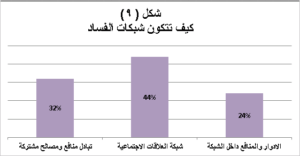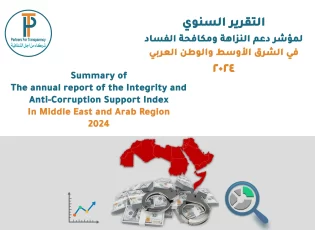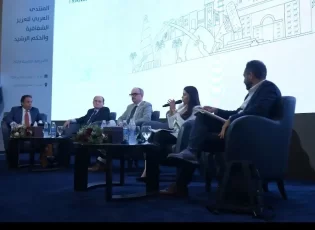
A complete diagram is attached to the policy paper Local Corruption Networks Policy Paper
an introduction
Local councils at their various levels are considered the first model school in the process of building democracy, as it aims to provide the opportunity for citizens to participate in managing their local affairs by themselves in order to consolidate democracy and deepen decentralization as well as raise the efficiency of the performance of local services and develop human resources. However, by following the local administration system in Egypt It is evident that there is almost unanimity on the spread of corruption in localities in Egypt, to the extent that localities can be considered the infrastructure of corruption, where forms and images of corruption have developed significantly and with them networks of corruption have formed, and then this paper aims to Monitor the initial situation of corruption networks in localities By answering a number of questions, including: -
- What are the factors for the spread of corruption in localities?
- What are the levels and forms of corruption in localities?
- What are the models of corruption networks in localities?
- How do networks of corruption form?
- What are the mechanisms to eliminate corruption networks in localities?
This study is considered one of the descriptive studies that relied on the social survey of the sample. A questionnaire form was used to collect data through a personal interview, in addition to analyzing some ready-made data. As for the research sample, the study data was collected from A sample of employees of local executive councils Which A simple random sample “Snowball sample“Its strength is 150 individuals by 25 individuals working in a number of local executive councils from the service directorates (education, health, and social affairs) and a group of neighborhoods represented in the central district, the Montazah district, the governorate general office andA sample of the beneficiaries of the services provided by localities A simple random sample of 150 individuals consisting of 25 people benefiting from the services provided in the local executive councils and the neighborhoods under study.
The study was divided into several axes, as follows:
First: Introduction to social networks analysis.
Second: Levels and forms of corruption in localities.
Third: Factors of spreading corruption in localities.
Fourth: Corruption networks in localities.
Fifth: Mechanisms for eliminating corruption networks in localities.
First : Introduction to Social Network Analysis.
This approach came in response to the inability to reconcile the individual and institutional aspects of the corruption problem. Supporters of this approach argue that the only way forward to explain corruption and identify ways to combat it is through the integration of economic, institutional, political and social perspectives.
This approach focused on corruption from a sociological point of view, as Jean Cartier Bresson believes that we must realize that modern political systems are characterized by a special nature based on common interests, and therefore the process of corruption has certain characteristics based on trust and the exchange of benefits and interests in addition to the fact that this process consists of The long term is long-term relationships that came as a result of corruption of state institutions and the collapse of its administrative structures, so that institutions became mere empty entities due to the rampant corruption of these institutions.
Social networks are analyzed in light of the relationships and links between the actors within the framework of the existing contract between the individual actors within the networks, and the relationships between the actors within the framework of the system or organization in which these actors are located. There can be many types of relationships in that contract. Research in a number of academic fields has shown that social networks operate on many levels, from the household level to the state level, and play a decisive role in determining how to monitor and solve problems. This approach can be used to measure social capital (Wasserman & Faust, 1994, p. 1).
Jean Cartier Bresson and Donatella Della Porta went on to say that there are models for corruption networks represented in informal social exchanges. Corruption networks are extensions of legal social networks. Corruption can be explained by a complex web of relationships and bonds between individuals. They also propose a similar model for the exchange of corrupt individuals within large social networks (Cartier-Bresson, 1997, p. 436) .
This entry focuses on the illegal exchanges of resources that expand and support the models of corruption networks, not only between the beneficiaries of the resources owned by the public sector and the public servant, but the overall system, as the whole society is responsible for the corruption of its organs and organizations by justifying these corrupt practices and silence on them, meaning that Corruption of this apparatus is primarily the result of corrupt acts prevalent in society; When a citizen gives a policeman an amount of money or a small gift in exchange for a service he has performed for him - that citizen has contributed to the corruption of this apparatus; This is because it opened the door for the policeman to get more compensation for greater services. This matter is not limited to the police, but extends to all other sectors of society, and if the police officer sees that a judge is receiving a bribe in exchange for obstructing the course of justice; Then this officer will reach a conclusion: if the judge profited from this behavior; It can also do so (Bresson, 1999, p. 48).
The approach to analyzing social networks for corruption is a broad intellectual approach that focuses primarily on the relationships between social network actors rather than their characteristics. It is assumed that our social nature and our actions have meaning only in the social context in which we are located. A social network is a social structure made up of individuals (or organizations) called “nodes”, which are linked to each other through certain types or more of ties, such as friendship, kinship and common interests, Or relationships from beliefs, science, or… etc, and a social network in its simplest definition is a specific map of relationships (Ercetin & Neyisci, 2016, p. 168).
When dealing with corrupt networks of actors or corrupt - we find that there is a lot to be gained by the beneficiary of corruption through his support for corrupt networks and his integration within them as a social network. Hence, corrupt networks are the result of interactions between social networks. Hence, the approach to social networks analysis focuses on the specific nature of social behavior on the one hand as well as its focus on analyzing social networks.
There are several characteristics of social networks analysis, which are: -
- Interdependence, interaction and mutual trust between actors and their actions and each other.
- Relationships and ties that allow for the flow of resources and the exchange of interests.
- The group of individuals who see the structural and organizational environment in light of the constraints and opportunities available to work and build networks.
- The political or institutional, social structures that involve permanent patterns of relationships that allow the formation of these networks.
Communication and interactions between actors within social networks grow both negative and positive according to the actors' particular needs (and desires, ability to influence the social environment). Usually, the actors have many relationships of a different nature with a wide range of different groups and segments of society. Some of these relationships overlap with others and some relationships are mutually exclusive. Consequently, the complexity of individuals ’relationships and their position within networks increases (Terán, 2010, pp. 12-13).
Della Porta believes that the main problem is the lack of clarity of vision, and that before you can jump to conclusions about the causes and consequences of corruption, we need a clear picture of the characteristics of this phenomenon. By answering a question that begins with “how” before you can answer the question that begins with “why.” And if the relationship between the two questions is close, there are basic elements that should be emphasized when analyzing corruption as these elements differ from one society to another and these elements are represented In the culture of society, its values and the customs and traditions they bear, as well as the necessity to link those values with the controversial cost of corruption (Bresson, 1999, p. 49)
Second: Levels and forms of corruption in localities.
Most of the study sample confirmed the spread of corruption in the localities so much that it became socially acceptable, since by asking the study sample from the beneficiaries of the services provided by the localities and a sample of the workers in the localities about the level and degree of corruption in the localities. 73% of the sample confirmed that the percentage of corruption in localities ranges from 70 %-80 % (largely needs governmental and societal efforts to stand together) and they see that there is intentional corruption that represents 50% from the percentage of corruption in the localities and is represented in bribery, favoritism and unintended corruption and it is the result of the employee's awareness and the weakness of his ability to perform work or the reduction of his powers or the lack of a climate or work environment that helps Upon achievement, 18% from the sample also reported that the rate of corruption in localities ranges from 50%-70% (in a medium-sized form that can be controlled). .

As for the most corrupt sectors in the localities, according to the order of the research sample for the most corrupt sectors, the study sample confirmed that neighborhoods, facilities and services (sanitation, hygiene, water, street paving, road works ... etc.) are the most corrupt, and this is clearly evident in the illegal construction, garbage accumulation in the streets and congestion of transportation Street cracking, followed by supply, and this is evident in the manipulation of prices and quality of food commodities, high prices, health, education, and solidarity.
And by asking the research sample about their confidence in the local administration of the governorate's resources, 68% of the study sample confirmed that they do not trust government institutions and that the governorate's resources are spent without achieving tangible results, 241 TP1T trust government institutions to some extent, and 8% believe that these institutions fully carry out their responsibilities Face .
Table (1)
Confidence in the ability of localities to manage the province
| Do you trust the ability of localities to properly manage the province's resources? | ||
| Yeah | No | To some extent |
| 8% | 68% | 24% |
The following is a presentation of the levels of corruption in the localities, pictures and forms of corruption at each level according to the classification of the research sample, in addition to a presentation of pictures of corruption in districts and neighborhoods according to the responses of the study sample.
By asking the sample members about the images and forms of corruption in the localities, the study sample confirmed that there are levels of corruption that are connected and support each other. The levels of corruption are as follows: -
- Corruption of junior employees: -
(72%) from the study sample confirmed that there are images of corruption that are considered a prevailing norm accepted by society and an employee's acquired right, and they are arranged according to the following form: -
- Bribery reduced by 31% It is facilitating illegal works that harm the public interest at the expense of realizing a personal interest (the offending building: where the neighborhood engineers issue licenses that violate the specifications or overlook actual violations in exchange for money, the cleaning company, the directorates' equipment).
- Favoritism, exchange of interests and courtesy at the expense of the public good By the ratio of 38%: “Shalalia”, especially in light of the large number of government procedures that allow the formation of networks between workers in different departments, for example teachers in schools exchange students for the Arabic language teacher (S) the student nominates the teacher (Y) who gives the student grades for the work of the year and explains the issues of the monthly exams, Likewise, the doctor in the hospital and the owner of the furnace for the supply employee. Thus, these networks are established and developed based on the principle of mutual interests.
- Tipping rate of 25% Which fall under several names of coffee, tea, transportation, which is giving an amount of money to an employee to finish you legitimate work without violating the law, but in a faster time.
- Failure to comply with official working hours by 6% This is due to the employee's commitment to more than one job in order to be able to fulfill the basic needs of his family members.
B . Leadership Corruption: The study sample confirmed that corruption at the leadership level justifies corruption for junior officials and makes it general acceptance in society. As for the forms of corruption at the level of local leaderships (agents of ministries, heads of neighborhoods ... etc.) are: -
- Wasting public money : This appears in the payment of bonuses to those who are not entitled to it, the facilitation of the appropriation of public funds, and the failure to take legal measures against those outside the law.
- Favoritism and power abuse : Circumventing the law and regulations to protect their followers and facilitate procedures for some people, whether in return for money or courtesy of friends and acquaintances, which is represented in Inefficiency of managers Their weak ability to make and take decisions, which makes them either a game in the hands of the employees or that they refrain from taking any decision, but rather carry out the work in a purely routine manner without any change in order to avoid making mistakes, especially since managers are often over the age of 55 and have no desire to renew or Developing work, but devotes all its efforts to ensure that this period passes peacefully without any change, either positively or negatively, which will negatively affect the services provided to the citizen and the efficiency of those departments, and the performance of the government apparatus becomes incompatible with the developments occurring in society and is unable to meet the needs of citizens.
As for the images and forms of corruption in districts and neighborhoods, the responses of the study sample came as follows:
- Directorate of Health Affairs: The sample responses came according to the following form: -
- Centralization and favoritism This is evidenced by the inefficiency of the managers and their intransigence in closing some clinics that serve poor areas despite the need for these areas for medical services more than others, and despite the fact that they serve a large number of residents of slums and poor neighborhoods. The delay in providing medical intervention is due to several reasons, including: the absence of the specialist doctor in hospitals or health units during the shift, failure to comply with work hours, and the small number or incompetence of doctors in some cases. Consequently, there are delays in providing medical care and medical intervention, which may claim the lives of patients.
- Low efficiency of workers Of doctors and nursing, this appears in the medical intervention that harms the patient as a result of a wrong diagnosis or an error during surgery. And the absence of standards for the quality of medical services, and this is evident in the low level of general hygiene and health safety in hospitals.
- Bribery and embezzlement of covenant This is evident in the violations related to tampering with granting sick leave to health insurance beneficiaries, whether in return for financial compensation, courtesy of friends and acquaintances, or the exchange of interests with the entity in which the employee works. Failure of nurses and employees to provide the service except after obtaining a tip, failure to abide by work rules, and misappropriation of custody of medicines and hospital feeding.
- Directorate of Education :
The sample responses came according to the following form:
- Mediation and favoritism Which is represented in appointing unqualified teachers with sufficient educational qualification, such as appointing a mathematics teacher with a Bachelor of Commerce, inequality in the application of the law and silence over the absence and delays of some in exchange for royalties, gratuities and gifts. Maintaining managers and mentors for a long time in their places they supervise, which leads to the growth of the network of corruption Sharing interests.
- Bribery and embezzlement This is evidenced by the manipulation of school feeding, school equipment and equipment, especially in technical education, for example, manipulating the prices of raw materials in capital projects, renting laboratories for private projects ... etc. forcing students to take private lessons under the pretext of increasing the density of classes, the inability of students to concentrate and leaking exams. Months for students.
- Moral corruption and lack of commitment By business rules This is evidenced by helping some students to cheat during exams and by manipulating the attendance and absence of students in exchange for in-kind or cash donations to schools. Exploiting technical education workshops and laboratories for the benefit of private projects, manipulating the measurements and quotations of raw materials in technical education, overlooking students ’wrong behaviors such as smoking in school.
C. Directorate of Social Solidarity:
The sample responses came according to the following form:
- Waste public money Through slow procedures, which leads citizens to miss opportunities to obtain aid, such as the Alexandria Initiative Without Firms and Fines: as the slow procedures and incorrect data missed the opportunity to help the robbed and robbed people in Alexandria, and the aid of those affected by the floods was stored until it was corrupted and executed without reaching its beneficiaries.
- Inefficiency of workers This is evident in the presence of unqualified directors, as most of them reached the position of director of administration according to the job hierarchy, by seniority and not by competence, or through mediation, favoritism, and his proximity to the ministry's agents and governors. This is also evidenced by the inaccuracy of the statistics and data issued by that authority as a result of overlapping specializations and repeated activities between departments. For example, there are five departments working to develop the skills of citizens on handicrafts and they are (productive families, vocational training, public service, clubs, women's affairs) and support these Projects are referred to non-governmental organizations, and the association may have more than one activity (for example, public service, productive families, and women's affairs). These associations make a report on the beneficiaries of the activity for each department, for example if the beneficiaries are 20, the association registers the beneficiaries three times and the beneficiaries on paper are 60 beneficiaries, while Actual 20 beneficiaries.
- Failure to adhere to business rules This is evidenced by the failure to adhere to the official working dates, the non-compliance with the requirements of occupying the positions such as an industrial diploma working as a secretary while this qualification is not identical to the job position, a two-year social service institute as a specialist while the specialist is a university qualification.
- The spread of networks of corruption and cronyism This is evident in the nomination for positions in the ministry’s training, manipulation of the disbursement of social solidarity pensions and disbursement to groups that do not deserve and do not apply to the law (relatives, acquaintances and friends) And manipulate the law And condoning the violations and corruption of leaderships and the manipulation of rules, regulations and laws in favor of corruption networks that extend to the central ministry and sometimes public security.
- Working in an insecure environment It is not suitable to deal with the public, the constriction of the units, and the absence of chairs and offices suitable for the number of employees.
- Counterfeiting This is done by making pension cards for those who are not eligible and paying pensions to deceased persons.
Dr.. Pictures and forms of corruption in neighborhoods:
The sample responses came according to the following form: -
- Bribery In return for forgetting the violating building and issuing building permits that do not conform to the specifications in exchange for money .
- Manipulating the law And exploiting its loopholes to turn financial irregularities into administrative errors.
- Facilitating the seizure of state land And demolishing ancient places.
- Inefficiency of workers Their poor performance and workers ’failure to carry out cleaning work, paving roads, sanitation and electricity, except after obtaining a bribe.
In light of the previous presentation, a set of results can be elaborated, including: -
- Favoritism, the abuse of influence, the exchange of interests and courtesy at the expense of the public good (networks of corruption) are the most dangerous and widespread forms of corruption in localities.
- Poor efficiency of workers and lack of commitment to work dates and rules is one of the most common forms of corruption in localities.
- Bribery and abuse of influence is acceptable and socially justified.
- There is a crisis of confidence between the citizens and officials in the localities as a result of the gap between the needs of the citizens and the development policies of the localities.
Third: the factors of spreading corruption in localities
Confirmed The study sample of the beneficiaries of the services provided by the directorates However, there are a set of factors that justify corruption and help spread corruption in localities naturally. The order of these factors came as follows: -
- Unevenness Great between Levels Access And declining wages staff LocallyT And their access to the lowest wages in the state usually drives them to accept bribes in exchange for making decisions that may negatively affect society, as these people prefer to achieve personal gains at the expense of society. As the wage and salary policy in the localities is not commensurate with the living conditions and the high prices, and the employee’s inability to participate in the amendment or change in work strategies, and in light of the weakness of anti-corruption strategies, the employee becomes permissible and justifies bribery, since, in the words of the sample (I am Abd al-Mamur, which is this ... Khirbanh… a high commissioner.) The majority of the study sample (86%) asserted that despite the increase in wages, it does not suffice the basic needs of the employee due to the high prices.
- Absence Accountability and poor punishment The real situation for senior officials and the weakness of the imposed penalties, in addition to ambiguity of decisions and conflicting regulations and laws, especially in light of the dual dependency to which service directorates are subject between the governorate and the relevant ministries, as well as the imbalance between authority and responsibility and the division of responsibility on the levels of the organizational structure of the directorates, which weakens accountability and punishment. There are no clear criteria for evaluating the leadership’s performance in light of meeting the needs of the local community. Rather, the criteria for evaluation are administrative in accordance with the procedures followed by the leaderships and the extent of their safety.
- Inadequate work environment (Limited space, lack of offices and chairs, presence of thugs, insufficient number of employees) Lack of empowering workers and providing them with the skills needed for their work through training . As for empowering workers and training them, 65% from the sample of local workers confirmed that training is just a routine, as the skills that an individual acquires from training are not applied on the ground except in the narrowest boundaries, and opportunities for obtaining training between the directorate, departments and units diminish besides that Training opportunities are insufficient and training topics do not meet the needs of workers as a whole. 31% believes that there are no training opportunities in light of daily work pressures.
- As for the Legislation quality The research sample confirmed that the legislation contains contradictions and loopholes through which corruption can be practiced, while 47 % confirmed that corruption consists in circumventing the law and penetrating it by bribing law enforcement officials to condone their violations.
- The abundance and complexity of the procedures besides the presence Societal culture Justify corruption, which drives the individual towards corrupt behavior, as corruption increases when justified by societal culture.
As for the factors of spreading corruption in localities, according to responses Local employees sample It came as follows: -
In light of the previous figure, it becomes clear to us that the results of the field study confirmed that there are a group of factors that contribute significantly to the spread of corruption in localities, which are represented in: -
- Severe centralization Which results in a number of administrative problems and waste of natural human resources, as 26% of the study sample confirmed that this problem is evident through red tape, procrastination and slow procedures, due to the lack of authority to make decisions except through the central ministries in Cairo.
- Centralization of authority and centralization of responsibility Which leads to the loss of the state and society's right to accountability, the deterioration of the quality of the services provided, and the absence of standards for assessing the quality, due to the dual dependency of the directorates between the governorate and the ministry on the other hand, as 29% from the sample of workers in localities confirmed that the administration in the localities is summarized in a set of procedures governing the workflow Away from the needs of citizens and workers.
- Unevenness Great between Levels Access The wages of local workers are low and they get the lowest wages in the country. Usually that drives them to accept bribes in exchange for making decisions that may negatively affect society, as these people prefer to achieve personal gains at the expense of society, as 21% from the study sample confirmed that the economic factor and low wages is the main reason for accepting bribes Especially in light of the corruption of the leaders and their lack of accountability.
- 14% from the study sample confirmed that Lack of employee empowerment Providing them with the skills necessary for their work through advanced and continuous training, as well as the inelasticity of laws, supports corruption and facilitates lawbreaking..
- 9% from the study sample confirmed that For cultural aspects A fundamental impact on the spread of corruption in the country, which may push the individual towards corrupt behavior, as corruption increases when justified by the societal culture.
Fourth: Corruption networks in localities: -
In light of the previous presentation, it becomes clear that corruption networks were formed over a long period. By asking the sample of local workers about corruption networks and how they were formed, the study sample confirmed that belonging to the National Party to obtain the powers and appointments of the first corruption networks was accepted and justified for their existence, as the Egyptian society in previous decades was characterized by class disparity. Between a controlling minority belonging to certain entities working to spread awareness of these entities and gain the support of the most trustworthy, beneficiaries, and supporters who are indifferent to the principle of efficiency or the general good of society, and between the majority suffering from low standards of living, poor social, political and economic conditions, and the absence of channels to express their needs And their problems, and a local administration system with which the values of innovation, scientific research, and professional and scientific seriousness retreated, and professional and career advancement is no longer based on educational attainment, competence and experience, but rather as a result of mediation, favoritism, kinship and partnership in corruption networks. Thus, corruption networks arose in light of supply and demand - and in the words of the sample members. The prevailing norm in government institutions is according to the saying of “Chelny and Shellek” - the majority offer to support it and Its support for these entities in return for obtaining services, whether in the form of financial or moral compensation (promotion, mediation for appointment) in addition to the ruling class's control of services without oversight or accountability and reliance on favoritism to accomplish work and obtain advantages in exchange for ensuring their loyalty and affiliation with these leaders.

Hence, mediation, favoritism, and the exchange of interests are the main determinants of the role of individuals and their position in corruption networks, and 44% of the study sample confirmed that corruption networks are based on social relations (kinship, friendship, marriage and kinship), which makes these networks so strong that it becomes difficult to penetrate them. This is due to the high degree of trust among the members of these networks, for example (a director of a department who is married to a director of another department and his sons work in a third department in the same institution and has relatives of the leaders in the ministry) The network also extends at all administrative levels starting from the central administration in Cairo and ending with the smallest organizational levels and may extend to public security Sometimes .
As for the exchange of benefits and interests, “bribery, partnership in private projects,” 32% of the study sample confirmed that it is the main factor in forming corruption networks, while 24% believes that these networks are formed in light of the roles and benefits. Each individual has a role and place within this network is determined according to the organizational level To which the individual belongs, and the gains are distributed in specific proportions according to the status and role of each individual in this network.
With the passage of time, a culture emerged that justified corruption and became a socially acceptable way to obtain rights, especially in light of low wages and salaries. Hence the analysis of bribery and the legalization of favoritism, corruption took other names such as “tips, tea, my municipality and transportation.” Corruption networks were entrenched in government agencies and became a general system in society, and the values of integrity and transparency retreated before it. Personal interests and benefits became what determine the form of relations within Corruption networks. Loyalty to the network of corruption and its interests is more important than loyalty to society and the public good.
The results of the field study revealed the following:
- Corruption networks arose in localities in light of the supply “from leaders who possess power and money” and the demand “workers in localities in light of the low standard of living and the absence of oversight and accountability.”
- The strongest networks of corruption are those that are based on social relations (kinship, friendship, marriage and lineage), which makes these networks strong to the point that it becomes difficult to penetrate them due to the high degree of trust between the members of these networks.
- Shared interests play a big role in forming corruption networks.
- Corruption networks often enjoy societal acceptance.
Fifthly: Mechanisms to eliminate corruption networks in localities.
There is a set of measures and mechanisms that the state must take at all levels, which all bodies must work to implement in a parallel manner in order to combat corruption in localities, and these mechanisms are as follows: -
- Rebuilding trust between the government and the citizen This is through the government’s adoption of policies that are transparent, accountable, responsible, responsive to the needs of citizens, respect for the law and the public interest, in addition to activating communication between citizens, governments and members of the People's Assembly through legitimate communication channels (electronic, written, and audible) and to subjugate the incumbents. While exercising the authority to be held accountable for their behavior, tightening penalties for misuse of position, and setting a set of strict criteria for evaluating workers and leaders in light of their ability to meet the needs of the local community and effectively contribute to formulating development and reform strategies in accordance with the needs of citizens and in a way that achieves the public interest and not in the interest of officials, leaders and businessmen. Emphasis on the necessity of having plans and strategies to anticipate crises, provided that there are specialized administrative units for follow-up and evaluation and then rebuilding those strategies in light of the changes that occur to society and meet its needs, provided that these units are characterized by independence, continuity and obligation of the executive authority and do not change by changing officials and are distinguished by It is transparent, subject to social and administrative accountability, and enjoys a level of m N flexibility and the possibility of change in light of the needs of society, based on scientific studies and not the views, whims and interests of leaders.
- Freedom of circulation of data and information. The state will work to activate transparency and support citizens and civil society organizations with free access to information related to decision-making by issuing a law that guarantees the freedom of data and information circulation. The more transparent, clear and open government transactions and processes are open to review, examination and verification, the more efficient detection and deterrence of corruption And contain it. Therefore, the Freedom of Data and Information Law will guarantee citizens the legal right to request and receive information on all functions and decisions of government institutions that are not related to national security and do not violate individual rights and privacy. In addition to the necessity of public information on government funding, procurement and contracting. And the freedom to monitor and criticize the actions of the government and the decisions it makes, and to express their concern or their rejection of certain policies or decisions through transparent and legitimate communication channels. “Electronic complaints are connected to government databases.”
- Activating local governance: Through the establishment of a Governance Support Unit in the governorate that would establish the principles of governance, follow up on the activation of its mechanisms, and evaluate the policies of localities in a way that guarantees support for decentralization and reliance on localities in both their executive, legislative or supervisory parts to reduce the burden on the central institutions of the state, and then provide many public goods and services for citizens and intervene to achieve growth In addition to providing internal security for citizens, the local councils are more able to manage their affairs in a more effective and efficient manner. They are also more aware of the problems of the local citizen and the best ways to solve them.
- Promote decentralization and simplify procedures And relying on modern technology to reduce bureaucratic defects in localities and improve public services management, decisions and issues related to daily life at the local level. Also, through decentralization, economic resources can be distributed better and more effectively to better meet local needs, especially in the presence of an elected and responsible local people's assembly. Before the citizens about meeting the basic needs of the local community.
- Activate accountability policiesThis is through a network of interconnected and interconnected systems that work intensively in order to combat corruption, and among these systems are the following: -
- judicial system More independent and transparent This is through the presence of well-trained judges, writers, prosecutors, and investigators who work with a high degree of efficiency and effectiveness, and tighten penalties in case of abuse of power, relying on modern technology to simplify administrative procedures in courts and relying on bar associations to spread awareness among legal practitioners, raise professional standards and monitor legal awareness Society, which leads to affirming the principle of the rule of law.
- Parliamentary and popular oversight committees To monitor more effectively the government in all areas and tighten control in particular on government and executive policies related to socio-economic security and support for social quality in society - health, education, housing, labor policies, supply, public works - and any parliamentary committee or popular committee can investigate doubts. Related to waste, fraud and abuse within the executive institutions, in addition to permanent committees to monitor public efficiency and the integrity of government policies, investigate allegations of wrongdoing, and give the Local People's Assembly strong accountability mechanisms, in addition to periodic evaluation by citizens of the performance of members of Parliament and the Local People's Assembly and in the event that the member obtains Bad evaluation for two rounds, he is denied candidacy for membership for a similar period.
- Anti-corruption bodiesThis is through the state’s establishment of a competent body to monitor the violations of public officials and search for evidence of violations. The role of this body will not be limited to receiving or verifying data, but the Anti-Corruption Commission will have the ability to hold accountable officials who are alleged to have violated laws and are referred to the judiciary and to submit periodic reports on corruption cases without political restrictions, in addition to these bodies enjoying relative independence. This committee works through a large number of well-trained employees who have an adequate level of socio-economic security to deter the temptations they may be exposed to by the corrupt leaderships and provide this committee with the financial and human resources necessary to carry out its mission to the fullest.
- Activating social accountability This is through networking between civil society and government society to spread awareness of the services provided by the state and accountability mechanisms, as well as spread awareness of rights and duties and the reflection of accountability on combating corruption, as accountability of citizens to public employees and government officials is the cornerstone of fighting corruption. The participation of citizens in monitoring the performance of the government and the demand to enhance transparency and expose the failure of the government and its misconduct is one of the most effective tools to combat corruption, improve the quality of public services, achieve social justice and sustainable development.
- Restructuring the administrative apparatus of the state: This is through relying on modern technology and striving towards building a knowledge society, in addition to establishing and maximizing the role of a specialized research unit whose tasks include monitoring and analyzing the problems that the administrative apparatus suffers from and linking them with human development and paying attention to second and third grade leaders to raise the values of creativity and innovation and develop performance evaluation systems to allow To evaluate the worker's performance in light of the ability to complete the work in the fastest time and with the highest efficiency, and to work to raise the employee’s efficiency and maximize the value of achievement. Addressing the inflation and sagging size of the administrative apparatus and eliminating duplication and conflict of jurisdiction between directorates, ministries and governorates, reviewing some of the current administrative structures and achieving balance between the administrative apparatus’s units and their subordinate departments so that their employees are redistributed to ensure the use of the surplus in some departments to fill the deficit in some The other, activating the role of monitoring and evaluation units, linking administrative reform and reforming municipalities.
Short link: https://pfort.org/en/?p=2565












